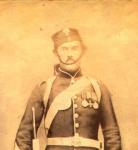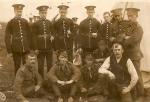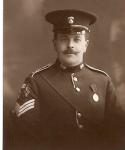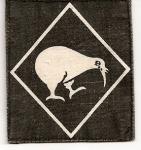-
Posts
1,065 -
Joined
-
Last visited
-
Days Won
1
Content Type
Profiles
Forums
Blogs
Gallery
Events
Store
Everything posted by Graham Stewart
-

Great War unit ID
Graham Stewart replied to Tony's topic in Great Britain: Militaria: Badges, Uniforms & Equipment
Tony, If your man A.R. Bailey was serving in a second line Territorial Force, A.S.C. unit then there is a good chance he may not have served overseas and therefore wouldn't have a Medal Index Card. Had he gone overseas with a first line unit he would have had two numbers on his MIC, one being '1106' and then a new number issued to all Territorial Force personnel as of 1917. Graham. -

Great War unit ID
Graham Stewart replied to Tony's topic in Great Britain: Militaria: Badges, Uniforms & Equipment
Doc, This is the bloke you're trying to trace. Graham. http://www.nationalarchives.gov.uk/documen...p;resultcount=1 -
Leigh, You an old "fuzzy wuzzy" then? Went back to that previous link with the Pioneer Sgt, a rare sight these days. One thing though since when has St.Georges Day been on the 22nd April, surely its the 23rd April The fur cap grenade worn by the Band & Pnr Sgt was eventally altered from those rough cast badges(which were an abortion) to one which reflected the regimental cap badge, both of which are now seen in bi-metal with a permanent polished finish, which do look very nice and the cap badges are a lot more robust than the anodised one. Ever read the booklet "Four Months in Winter" the story of 2RRF during their N.Ireland tour in 1972? Maybe a modern item in terms of collecting and well overlooked, but not easy to come by and I think I've only ever seen a few copies all the time I've been collecting. As the Northumberland Fusiliers take up the bulk of my collection, it naturally extended into the RRF, unlike other Fusilier collectors who finish in 1968. As a result I have managed to collect a full run of "The Fusilier" the RRF Regimental Journal from 1968 to the present and still get it sent twice a year. Last weekend I was at the RNF Other Ranks Club dinner, which on this occassion was a commemoration of the nine Northumberlands & three Argylls killed on the 20th June 1967 during an Ambush in the Crater District of Aden. What an emotional opening - Northumbrian piper playing a lament, then an Argyll Bn,RoyaL Regt of Scotland piper playing the "Barren Rocks of Aden". As their names were read out a Quarter Guard furnished by the 68th Foot Re-enactment Group "reversed arms". Very difficult to hold back the tears. Was sat next to Sgt Major Heweson, 1RNF/1RRF and took up old Ed Forrest 1RNF/1RRF and had a really good evening. Heweson had some cracking stories to tell from his time with 1RNF and the first N.Ireland tours with 1RRF. thoroughly enjoyed myself. Graham. .
-

RN Trade Patches
Graham Stewart replied to JimZ's topic in Great Britain: Militaria: Badges, Uniforms & Equipment
I'm hoping the images of older Fleet Air Arm badges will be attached and viewable. For those interested in the later FAA badge with the letters 'AE' below the wearer was a "Naval Aircfaft Mechanic(Airframes & Engines)", which in 1980 became "Aircraft Engineering Mechanic(Airframes & Engines)". The only reason I know that is because I was one from 1975 through to 1981, serving with 707 Naval Air Squadron, H.M.S. Heron; 849 N.A.S. - H.Q.Flight, H.M.S. Fulmar & 'B' Flight, H.M.S. Ark Royal; S.H.I.F.T.U., H.M.S. Heron which becames 700(A) N.A.S., then 899 N.A.S., H.M.S. Invincible. For my sins I'm still working on aircraft as a civvy and now Hawks of 100 Sqdn, R.A.F. Leeming. Graham. -

Photo Help
Graham Stewart replied to Bear's topic in Great Britain: Militaria: Badges, Uniforms & Equipment
Although taken much later c.1860, this photo of Patrick McHale, V.C., 5th Fusiliers, shows that scarlet within the jackets remains a mid-colour during this photographic process, therefore I'm still convinced the shell jacket is that as worn by bandsmen, with the addition of coloured facings on the collar and cuffs, whereas all of my illustrations show Drill Order as being plain white throughout. Graham. -
Stuart, Apart from being green with eny at your latest acquisition, I can inform you sadly, that all NF battalions were entitled to were the 'V' on their foreign service pattern helmets. If it's not marked with owners name and number then you'll be hard pressed to identify it's original owner, but it's still a beautiful example of what they were wearing. Any chance of some more photo's for my records?? Hopefully a picture of the 2/7th Bn, N.F. in Egypt will be attached. Graham.
-

Photo Help
Graham Stewart replied to Bear's topic in Great Britain: Militaria: Badges, Uniforms & Equipment
Not really sure about the one on the left, but the one on the right is wearing a "shell jacket" c.1856 pattern. The obvious thing is it's colour, which would appear to be white, which was usually worn in "drill order". Having said that this shell jacket has facing collar and cuffs, not usually seen in drill order, as both collar and cuffs are normally plain white in D.O., so it's quite possible that this could be a bandsman. The badge in the forage cap is unusual as often only regimental numerals are displayed, apart from Fusilier/Light Infantry regiments which would use additional grenades/bugles. I personally can't see any collar badges, which weren't introduced until around 1874. As to the unit, not a clue, but still nice to see. Graham. -

HMS Ganges now
Graham Stewart replied to Chris Clark's topic in Great Britain: Research, Documentation & History
HMS Ganges, brings back a few memories as I was in one of the final recruit classes through there in November 1975. I can still remember the huge gun sheds where drill was practised during wet weather and all around the shed walls were the figure heads of masted ships long gone. I can also recall above one of the walkways a large carved motto - "Fear God, Honour the King", and I remember being very impressed by it and wondered how many other trainee sailors had passed beneath it. Perhaps one of the scariest duties there was down at the laundry come drying room, which hadn't changed since the turn of the century, the frightening part being it was also doubled as the morgue. Graham. -
Stuart, Sadly no major work has ever been written which depicts the various badges/cloth flashes that were worn on foreign service helmets. As an example I was looking at some 2nd DLI photo's, taken in India 1912, at the weekend and didn't realise that like the Northumberland Fusiliers, that they also wore flash of cloth behind the pagri, although not as deep, but in dark green. On the left/right(can't remember which) side of the helmet was an oblong cloth patch with the intials D.L.I. in regimental colours. Have seen many such examples over the years, but sadly no references. Graham.
-

red coat
Graham Stewart replied to Mossy's topic in Great Britain: Militaria: Badges, Uniforms & Equipment
I believe Mike had gone through T.F. Regulations, Circular Instructions for the T.F., Kings Regulations, Army Orders, Army Council Instructions and Dress Regulations, all of which are the governing material regarding the organisation and running of the Army. Equivalent documentaion can be found for both the Royal Navy and Royal Air Force, but even today I'm astonished at how many people seem to think everything was carried out on the whim of a Colonel. Graham. -

red coat
Graham Stewart replied to Mossy's topic in Great Britain: Militaria: Badges, Uniforms & Equipment
Chris, Seriously though are you telling me that you've never seen Manchester Territorials in scarlet between 1908 and 1914, or do you just not bother picking them up? As much as I love seeing them in SD, I love them even more in scarlet, especially when you see the changes in the pattern of the jackets. Graham. P.S. Remember seeing a photo album at Tynemouth Fair some years ago that was stuffed with Manchester City Battalion photo's, with some nice head and shoulders showing S/T's. Bet that would have made you happy? -

red coat
Graham Stewart replied to Mossy's topic in Great Britain: Militaria: Badges, Uniforms & Equipment
Chris, Dear me, you must have missed some good photo's then. 4th Bn, NF possibly their last annual camp at Greystokes, Cumbria 1913. -

red coat
Graham Stewart replied to Mossy's topic in Great Britain: Militaria: Badges, Uniforms & Equipment
Chris, The T.F. were wearing scarlet right up until August 1914. I have over 1,000 photos of the Northumberland, many of them T.F. photo's taken at annual camps before the war and a lot of them are in scarlet. SD became your uniform for daily wear, but they were still be issued with scarlet. Colour Sgt Boyd, 6th Bn, N.F.(T.F.) c.1912 Graham. -

red coat
Graham Stewart replied to Mossy's topic in Great Britain: Militaria: Badges, Uniforms & Equipment
Territorial Force Regulations 1912(amended to 1st December 1914). Para 453;- Except in the case of Corps for which special uniforms have been sanctioned, full dress uniform will, as far as possible, conform to that of corresponding units of the regular forces, silver lace and white metal buttons and ornaments being substituted for gold and gilt metal. Yeomanry regiments which prior to the formation of the Territorial Force, had permission to wear gold lace and gilt ornaments retain this distinction. So this uniform pre-dates these regulations, by having silver lace. You could also apply for a T.F. commission from the age of 17years old. Leigh, Yes - "FASA" is found in only one particular pattern of NF O/R's shoulder title, the remaining patterns, of which there are a few, have "FATA". Graham. -
Franco, The London Gazette reference to 'Peterborough', is his place of residence at that time. This would certainly fall into place as the 3rd Battery of 1/4th Brigade was infact from Peterborough, Northamptonshire. The Medal Index Card references refer you to the actual pages of both the British War & Victory Medal Roll Book and the 1914-15 Star Medal Roll Book for the Royal Field Artillery. Neither of these books are on-line I'm afraid from which to download pages. The SWB reference refers to the pages of the Silver War Badge Roll Book, so it appears he may have been awarded a Silver War Badge too, even at that late date. Again this book is not on-line for downloading information. Being discharged under Kings Regulations, Paragraph 392(xvia) usually is an indication that he was "no longer physically fit for war service". The one thats currently puzzling me is 73/270, as by 1916 all batteries were lettered rather than numbered and so you would have had 'A', 'B' & 'C'/270, referring to the unit he was serving in. All the same Franco you have a good find there a Victory Medal to a man who was also awarded a Distinguished Conduct Medal, and medal collectors would be only too pleased to have such an item, although medals to Corps units don't seem to attract the attention as those of infantry units. All you need to do now is try and find the others, so best of luck. Graham.
-
Franco, Both Medal Index Cards are correct for the one individual. 4408 Acting Battery Quartermaster Serjeant George A. Barker was infact a member of the Royal Field Artillery(Territorial Force) and was probably serving in the one of the Hertfordshire Batteries of the 1/4th East Anglian Brigade, R.F.A.(T.F.) of the 54th(East Anglian)Division and we know this through his second number 891271 which was one of the new six figure replacement numbers issued to all members of the Territorial Force in 1917, replacing all the old four figure numbers. The East Anglian Division and in particular the Hertfordshire Batteries of 4th Artillery Brigade were given the following block of numbers to replace their old ones;- 890001 - 895000. In 1916 the 1/4th East Anglian Bde, R.F.A.(T.F.) was renamed 273rd Brigade,R.F.A.(T.F.) and then changed to 270th Brigade, R.F.A.(T.F.). When 54th Division left for Gallipoli it's artillery brigades were left behind in England and they then proceded to France in November 1915 and were attached to 33rd Division. In February 1916 the artillery moved to Egypt to rejoin 54th Division. Do hope you're able to make sense of this. Graham.
-
These are the one's I mean. A technical hitch meant I couldn't post them in a quote panel. Anyway as said they can be found in the Australian uniform link that I added, just look for the section covering brassards. The link takes you to an Australian members Vietnam collection. Graham. PS, The "tactical recognition flash", as they're now called, below the wings on the above brassard is that worn by the Guards.













